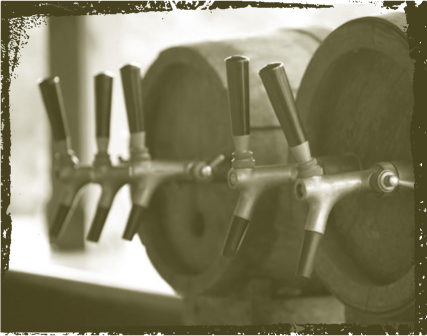
There is an old debate. Bavarian wheat beers are bottled with extraordinary effervescence, both to create a lively body and to a give the beer a dense pile of snowy head. The trick is to get the beer from the bottle into the glass with two or three fingers of head—not half the glass.
There are two methods to accomplish this—two schools, even. Practitioners of the more traditional approach pour the bottle at a slow trickle, holding the glass at a 45-degree angle. Even this gentle technique is enough to rouse a billowing head. Other, more show-offy types place the glass over the bottle and then flip it so the bottle is held directly above the vertical glass. The pourer raises it slowly as the beer gurgles out. It takes talent to hold the lip of the bottle just above the rising surface, and failure results in an unwanted geyser. Both camps agree that the ritual is complete only when the dregs of the bottle have been deposited on the head, and the feet of the glasses have been clinked against each other in cheery salute. (I suppose that when you spend idyllic afternoons in the dappled sunlight of a Bavarian biergarten, you need something to debate.) Prost!
Do you need to pour a beer in such a prescribed manner? Must it be decanted in a weissbier vase? What about the yeasty lees—do you have to cloud your beer with them? The short answer is no.
Select any style of beer, and there will be rules governing how it should be served. The package it arrives in, the temperature it’s supposed to be served at, the glassware appropriate to highlight its features, and the manner of pouring—some or all of these will be resident in the high ritual of service. A properly educated beer geek should know his weizen glass from his pleated lambic tumbler, and it’s actually a lot of fun to understand the science and cultural expectations (which are sometimes presented as science) behind them. But all these rituals have one ultimate purpose: to accentuate the sensual enjoyment of drinking a beer. Although someone will inevitably tell you you’re drinking your beer “wrong” (no matter how you’re doing it), it’s a good idea to learn how the manner in which it is served affects its appearance, aroma, and taste—and then go ahead and follow your bliss. ■
UNLIKE MOST BEVERAGES, beer comes to us not only in different packages, but in a variety of different states. It may be naturally carbonated and “alive” (or, more precisely, containing live yeast), as in cask ale or container-conditioned beers. It might be artificially carbonated, as in keg beer. Or it might be enlivened with a nitrogen mixture rather than straight carbon dioxide. Any discussion of how to serve beer begins with how that beer comes to us, so here’s a brief rundown on common states and packaging.
■ Cask Ale. The most elemental and ancient style of beer is “conditioned” right in the cask. The beer actually goes into the cask—once wooden but now usually metal or plastic—before it has completely finished fermenting. As the yeasts continue to munch away, they expel carbon dioxide, naturally carbonating the beer. The casks arrive at the pub, where a cellarman will let them settle and finish fermenting. When the yeast has fallen out of suspension, the beer can be tapped. In most traditional setups and throughout Britain, the cask takes on air as it drains, limiting it to a very short life—a few days at most. After that, the beer will turn sour. Modern systems do exist that replace the cask’s empty space with sterile CO2, but traditionalists frown on this practice.

■ Bottle-Conditioned Beer. The same principle applies here. Beer is packaged before it has completely finished fermenting, or is primed to start a secondary fermentation. Bottle-conditioned beer will have a dusting of yeast in the bottom. Once you open the container, that yeast will slowly be roused by the bubbling carbonation, so it’s usually best to decant it immediately.
Pasteurization and Sterile Filtration. Breweries have to make a calculation when they bottle their beer. On the one hand, they want to inhibit the action of beer-spoiling microorganisms, while on the other, they want to lengthen shelf life. Pasteurization accomplishes the first goal. There are two methods. “Tunnel pasteurization” exposes packaged beer to a ten-minute spray of 140°F (60°C) water; in “flash pasteurization,” breweries heat the beer to 160°F (71°C) for less than a minute before rapidly chilling it back down.
Pasteurizing beer has two big downsides. Heating actually accelerates the aging process, so pasteurized beer stales faster. It also dulls delicate flavors and aromas, which may be the highlight of some specialty or craft-brewed beers. Some breweries use a process called “sterile filtration” to split the difference. In this process, also called “cold sterilization” or “draft filtering,” breweries use an extremely fine filter to remove the cells of yeast and microorganisms. It doesn’t change the chemistry of the beer like pasteurization, but it does remove flavor- and aroma-carrying particulates.
■ Regular Bottles. Bottles are the earliest form of take-home packaging, and they’re still going strong. They continue to have a more exalted status than lowly cans, in spite of the fact that they don’t do quite as good a job protecting the beer from harmful light.
■ Cans. Cans have some advantages over bottles. They are lighter, which not only makes them more convenient, but they require less energy during shipping. They protect beer completely from light. And for small breweries, canning lines are cheaper to install. Despite old prejudices, the metal in no way affects the flavor of beer—modern cans are lined.
■ Kegs. This is the big innovation that largely displaced cask ale. Beer in kegs is artificially carbonated and pressurized with CO2 to stay unspoiled indefinitely. Stored at cold temperatures, kegs preserve the beer the best, but it will eventually suffer the ravages of time like any beer.
■ Nitrogen (“nitro”) Beer. Because yeasts naturally produce carbon dioxide, it is the most common way to carbonate beer. In the 1950s, however, Guinness discovered that beer could also be enlivened by nitrogen gas. Guinness fans know what the gas does to beer: It produces a unique cascade of bubbles that eventually form into an extremely tight, mousse-like head. Any beer may be nitrogenated, even when sold in bottles or cans.
■ Growlers. Brewpubs and craft beer bars commonly sell half-gallon jugs known as “growlers.” The system dates back to at least the nineteenth century as a way for patrons to take beer home with them from the pub. Publicans pour the beer straight from the tap, and the jug will remain fresh and carbonated for several days—though it will quickly flatten after it’s opened the first time. ■
THE AVERAGE REFRIGERATOR is set to about 36°F (2°C), the ideal temperature for a frosty one. The problem is, you don’t want a frosty one. Of all the things that affect the presentation of a beer, temperature is the most profound. Each style has an ideal range that allows the beer to express the flavors and aroma the brewer intended. Cold inhibits these qualities—and anesthetizes the tongue to boot. Of course, beer can be too warm, too, with predictably sticky, heavy results. Beyond flavor and aroma, temperature affects carbonation as well as texture and mouthfeel.
Most chapters in this book have a recommendation of serving temperature appropriate to style, but there are some general rules of thumb. English ales, which have delicate flavors that unfurl as they shake off the cold, should be served at the warm end, around 55°F. Lagers, on the other hand, have clarion notes of malt and hop that should come across without distortion. The cold—around 40°F—helps showcase these elements. Intensely scented hoppy beers—America’s specialty—must be a bit warmer to showcase their aromas. Summery light beers are thirst quenchers, built for being served chilled.
No matter what temperature your beer is when it enters the glass, it’ll warm up as you drink it. Notice how its properties change. Cold can help conceal faults in a beer, but if you’re in a mood for diagnosis, you might like to let the beer reach room temperature. Any faults will be on vivid display then. Temperatures affect flavors and aromas predictably, but the way we react to those flavors and aromas are individual. Experiment, and find out what the right temperature is for your tastes. ■
THE HISTORY OF pale beers is usually told through the lens of malting innovation. Before the seventeenth century, malts were crusted with heat and smoke and the beers they made were nut-colored to coal-black. True enough, but why then did it take so long for paler beers to catch on? They required a parallel innovation—the mass production of clear glassware. Before clear glass came along, drinking vessels were made of opaque materials like pottery, wood, leather, or metal. But with glass, punters could finally get a good look at what they were drinking: chunky, murky, river-water stuff—some of the brown beers at the time must have failed to impress (and that’s being generous). So when pale ales and lagers came along, refracting golden light through their sparkling clarity, people were magnetized by the sight of them. Beer was never the same again. We mainly use our noses and mouths to explore beer, but glassware finally gave us the chance to use our eyes.
THE VISUAL ELEMENTS of beer aren’t limited to color; it foams and bubbles like a cauldron and leaves tracery on the side of the glass. To highlight these features, breweries have been designing proprietary glasses for decades. In some cases, glasses were designed by pub owners for durability and ease of use. Whatever the origin, a collection of a dozen or so glasses have become standardized for serving a style or category of beer styles. The most important are listed below.
It is worth mentioning that while the glasses are effective at highlighting their corresponding beer styles, it’s not necessary to have a different glass for every beer. It may even be overly fussy. English and American pint glasses do a great job with the majority of beers. A smaller glass like a snifter, tulip, or goblet—or even a wineglass—is nice for stronger specialty beers, and a tall, slender glass is great for pilsners and light golden ales. On the other hand, you can really impress guests with a fully stocked cabinet!
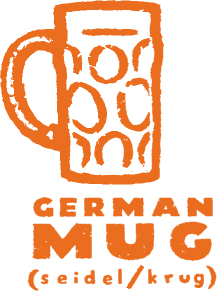
A more modern version of ancient stoneware mugs, ideal for festive drinking. Handles and thick walls keep beer cold in warm weather—and aid hearty toasts.

Although they look like snifters, tulip glasses are quite different. The stem keeps the beer cold, and the outward flare at the lip allows the drinker to receive beer and head simultaneously. Use particularly for highly effervescent Belgian ales.
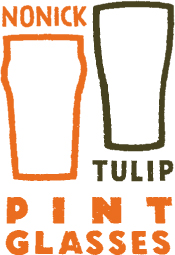
British publicans developed the nonick (“no-nick”) glass (left) in the 1960s as a stackable vessel. The tulip pint glass (right) hails from Ireland. Both are great workhorses for British and American ales, and the tulip in particular is excellent for conserving aromatics.

Stange is the German word for “rod” or “stick,” and these glasses are common for kölsch and have qualities similar to a pilsner glass, accentuating the beer’s clarity and bead. Alts use a similar glass called a becher.
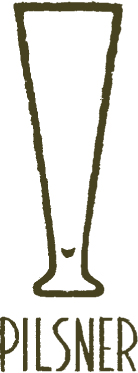
A classic design that showcases a pilsner’s golden clarity, sparkling effervescence, and snow-capped head.

Snifters were developed for digestifs like brandy—and they do a great job with similar high-alcohol beers that open when they’re warmed by the hand.

A straight-lined, Teutonic version of the tulip. Perfect for strong, sipping lagers like doppelbocks.

Designed for effervescent abbey ales, goblets prevent overfoaming and exaggerate deep colors; often enlivened with nucleation sites. They vent rich alcohol aromas and promote sipping.

Although it looks like a pilsner glass, the bulb-like top accommodates a towering head and, later, captures aroma. A good weiss “vase” has a thick foot to tap during toasts.

Actually developed as a shaker for mixed drinks, this durable pint glass is nearly ubiquitous in pubs. Unfortunately, it’s ugly and suppresses aromas.

A specialty glass for special beers, particularly effervescent beers and fruit ales. Like a pilsner glass, it conserves carbonation and highlights color.

Once common throughout the pubs of England, this pint glass now has the look of the past. It’s quite useful, though—the handle keeps the beer cold (and hand warm), and the facets highlight the beer’s color.
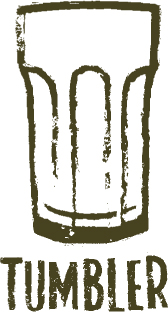
Used for rustic styles like witbier, saison, and lambics. By tradition, lambic breweries typically use a pleated tumbler, while witbiers are served in chunkier jelly jar–style glasses.
Frosted Glasses. It used to be common for nicer restaurants and bars to store beer glasses in a specialized freezer that coated them with a layer of cloudy ice. On the theory that no beer could be too cold, these glasses protected against thermal loss—and turned the figurative “frosty” mug into the literal. As a function of serving ritual—and visual panache—the idea has a lot of merit. As a way to serve the needs of the beer, not so much. Not only do frosted glasses help keep icy beer icy, they actually add ice to and water down the beer. The crime is not so great when committed against a mass-produced light lager, but with any other beer, a frosted glass will appreciably diminish the experience. Request a regular glass instead.
An energetic writer could devote an entire book to glassware; because glasses have evolved in tandem with beer to highlight the virtues of local specialties, there are nearly as many glass shapes as there are styles of beer. The proper glass for an abbey tripel is a wide, stemmed goblet. Kölsches call for the opposite—narrow, rod-straight glasses called stanges. I’ll spare you a full volume devoted to the ins and outs of glassware, but I have highlighted some of their most important features and offer up a few essential types: see pages 547 and 548–549, respectively. ■
THE ACT OF POURING out a beer—decanting, if you prefer—is not rocket science. On the other hand, if you’re not paying attention, you may end up with a mug full of foam or a glassy-topped beer with no head at all. Some styles, like Irish stouts or Bavarian wheat beers, practically demand to be poured out, and publicans have to learn the proper way to do so. (Decanting helps rouse the yeast in a wheat beer and release the strong carbonation; and Irish stouts are served on nitrogen, which comes boiling out of solution when the bottle or can is opened.) But every style looks good with at least a skiff of foam, and a finger or two is a good mark to shoot for.
When you begin to pour out a beer, though, you may not have any idea how carbonated it is. (Carbonation is itself not constant—it’s far more difficult to encourage a head in a beer of 38°F than at 55°F.) Before you pour without reservation, test the beer: Hold the glass at a 45-degree angle and begin pouring very slowly down the near side of the glass. Highly carbonated beers will begin to foam, while flatter beers will drizzle down without any sign of head. If you’ve got a highly carbonated beer, keep pouring down the side. You can moderate the amount of head you create by pouring more or less vigorously.
Honest Pints. Imagine you went to a gas station where the advertised price looked like a bargain, but where the pumps were calibrated to deliver 105-ounce gallons. At another station, the price was higher, but the gallons were a standard 128 ounces. In essence, this is the situation in which American pubgoers find themselves. When we go out for a beer, we may be getting anywhere from 12 to 20 ounces in glasses all called “pints.”
The main culprit is the nearly ubiquitous shaker pint, the thick, conical vessel favored by bars for its durability. Most are 16 ounces, but some—with the same dimensions—have thick bottoms and hold only 14 ounces. These are the infamous “cheater pints” that sparked a nationwide project to bring transparency to glass sizes. (Full disclosure: I was one of its founders, though I’m no longer involved.) The problem goes beyond deception, though. Some pubs serve 20-ounce imperial pints, and some even serve 23-ounce imperial pints—on the assumption that with headspace, they will give a full 20 ounces of liquid.
Other countries regulate glassware measurements, but the United States leaves it to the retailer. As a consumer, one thing you can do is ask your server how large their glasses are. If you’re suspicious, ask them to switch to “honest pints.” In the absence of agreed-upon standards, customers have to be vigilant.
If the beer looks fairly still, hold the glass vertically and lift the bottle six or eight inches high, pouring directly and vigorously into the middle of the glass. You don’t have to pour fast, and in fact, if the liquid comes out in glugs, it will make large, unattractive splash bubbles. It’s better to hold the bottle farther away from the glass so the beer plunges into the center, an act that will encourage it to release its carbon dioxide and form a head.
A final note: Before you pour, have a look at the label or bottom of the bottle to see if the beer contains yeast sediment. If it does, you have a decision to make: If you pour out the entire bottle, the last bit will be hazy with yeast and it will cloud your beer. If you don’t, you leave a mouthful of precious beer remaining in the glass. A dilemma! My solution is simple: I pour out most of the beer, leaving enough behind so that I don’t cloud the beer. Done right, the residue amounts to just about a swallow—delicious. ■
THE MOMENT BEER leaves the brewery, it begins to change. The effects are minor at first and vary depending on the type of beer, what it was packaged in, and how it was stored. In science-y terms this is because, according to Belgian researcher Bart Vanderhaegen, “the constituents of freshly bottled beer are not in chemical equilibrium.” And that is because, as you already knew, “thermodynamically, a bottle of beer is a closed system and will thus strive to reach a status of minimal energy and maximal entropy.” In other words, the chemical compounds that create a perfectly fresh, vivid-tasting beer are not stable.
It is therefore almost axiomatic that beer is better the fresher it is. Almost. There’s a small category of beer—strong, usually dark—that is actually improved by those chemical changes. Or if not improved, altered in interesting and pleasant ways. Left alone in a cool cellar for months or years, these beers develop rich, plummy depths—and pulling them out for a special occasion can be a real pleasure.
In most aging beer, certain compounds that taste like cardboard, sherry, honey, and red fruit increase, while others like subtle fruity notes and bitterness decrease. These effects are accelerated at warm temperatures and in the presence of oxygen—which means packaging type and control is critical. Because beers differ chemically, the changes aren’t consistent across types. Ales change more than lagers. The act of roasting malt creates a chemical change, the Maillard reaction (see page 521), and in beer with roasted malt these compounds behave differently. A similar dynamic is at play with alcohol, which increases the sensation of liquor-like notes of sherry or whisky with age.
At first, it’s difficult to get a cellar up and running—delayed gratification is not a beer drinker’s strong suit. But if you can manage to put a few bottles away every year, it won’t be long until you’re holding tasting parties just to clear out more space. Patience! If all of this sounds intriguing, you’re ready to start building a cellar, which really just needs to be an undisturbed space that’s cool and dark (say, behind the basement stairs or in a wine chiller with the racks removed). Store beer below 60°F, but don’t refrigerate it—that will slow the aging process too much. Some temperature fluctuation won’t hurt, but if your cellar regularly gets warmer than room temperature, that’s a problem. The best choices for cellaring are those beers with an alcohol percentage above 8% ABV—they’ll age even better if they’re north of 10%.
If the date is not marked on the bottles, note the year and month each beer was made. Place capped bottles standing upright and corked bottles on their side. Bottle-conditioned beer ages best, so look for bottles that have a layer of yeast on the bottom (but don’t rule out those that don’t—see Stocking Your Cellar, above). Finally, buy several of each beer you wish to cellar; that makes it possible to hold periodic tastings with several vintages of the same beer.
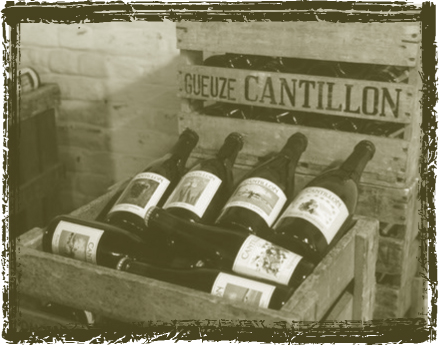
Brett beers like lambics and gueuzes ripen with age, making them interesting candidates for cellaring.
Stocking Your Cellar. Any well-stocked cellar has a few of the classics—imperial stouts, barley wines, strong dark abbey ales. These kinds of beers were designed for storage and in some cases, actually need a few months to coalesce. Beers made with Brettanomyces will definitely change. Even a beer as light as Orval (bottled at 6.2% ABV) will change markedly over the course of a year. Bigger beers last even longer. In that same vein, lambics and particularly gueuzes will also ripen nicely as the wild yeasts continue to slowly eat away remaining sugars. Some beers don’t need a lot of time—just enough to smooth a bit. American craft breweries often rush winter warmers to market, and you might find that buying them in October and saving them for the Christmas feast is ideal.
If you’re considering cellaring beer, there are a few rules of thumb to keep in mind. For beers without wild yeasts, only consider aging those stronger than 8% ABV—the higher the alcohol content, the longer it is likely to improve. Among these stronger beers, two considerations are color and hops. It’s best to age beers with some color, though they don’t have to be black (amber-colored barley wines seem to do fine). Hoppy beers are trickier. Extremely bitter beers may need some time to soften, but beers with delicate, fleeting aromas and flavors will lose their most important qualities. So dry-hopped double IPAs should not be aged, but bitter American barley wines should.
Beers made with wild yeast and bacteria (lambics, wild ales) are another category that generally ages very well, even at modest strengths like 5% ABV. Because the yeast is active, it continues to consume sugars and—crucially—oxygen. The evolving biochemical changes help preserve these beers. There is one note of caution, though: Consider buying more than one bottle of wild beer if you plan to cellar it. As the Brettanomyces continue their work in your aging bottle, they may take it beyond the point you find most pleasant. Try a bottle periodically to make sure it is still palatable.
What you’re looking for in aged beer is a depth of flavor. Eventually, every beer will begin to lose integrity and the flavors will become thin and flat. A beer with “good age” will have a hearty resonance. The flavors will seem almost a bit stewed—all the sharp edges worn off, replaced by burnished, refined, rounded flavors. Oxidation has a distinctive aroma and flavor; at low levels it’s like the smell of old books—pleasantly musty—but once it gets too strong, it has the quality of wet cardboard. Most aged beers will take on some oxidation—it’s part of what gives them their “aged flavors,” but it should enhance the caramel and dark fruit flavors or give the beer a sherry-like refinement, not overwhelm the beer. If you try a particular vintage and like the results, consider drinking the remaining beers—it’s a minor tragedy to wait too long and have a beer wimp out on you. ■